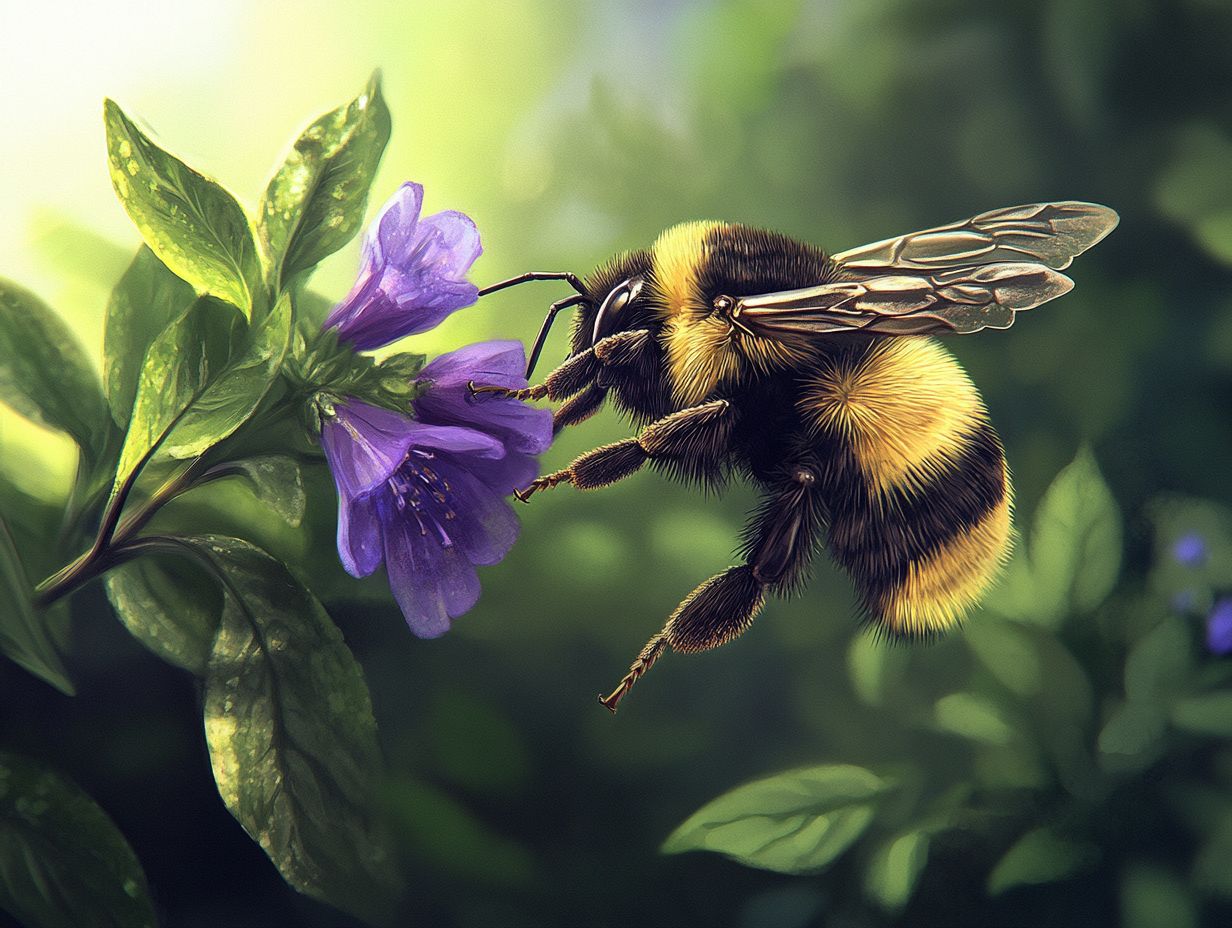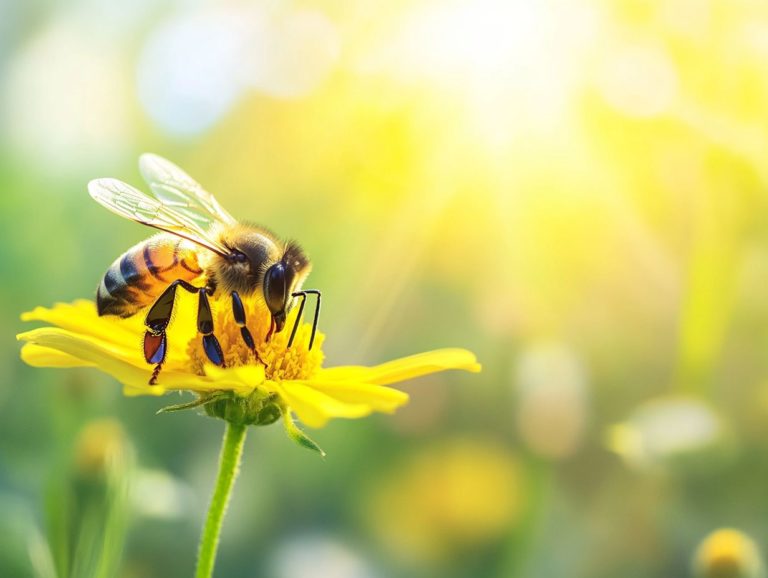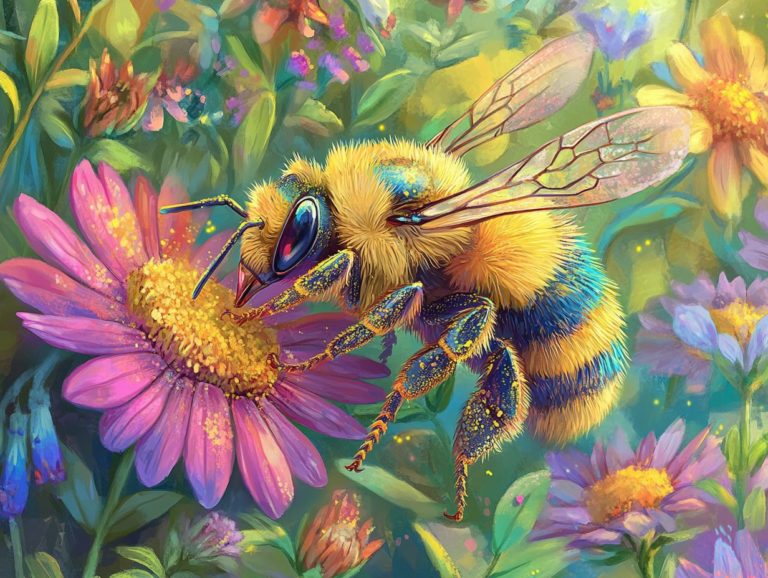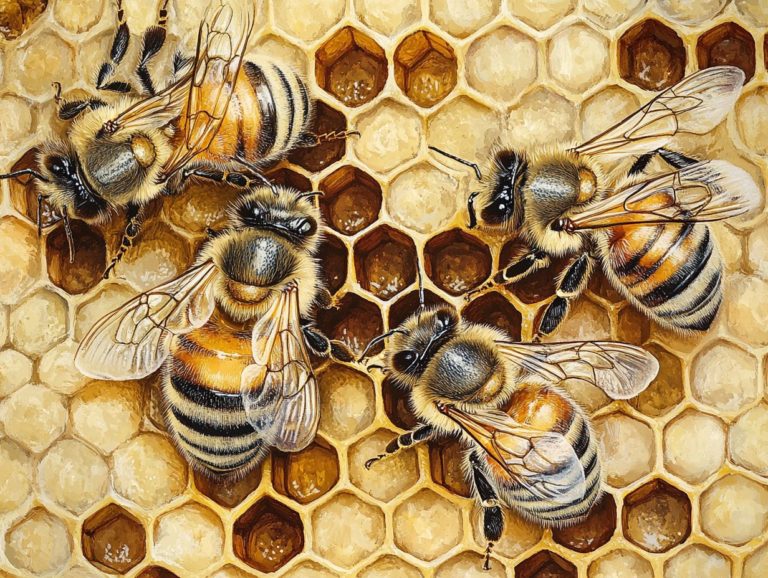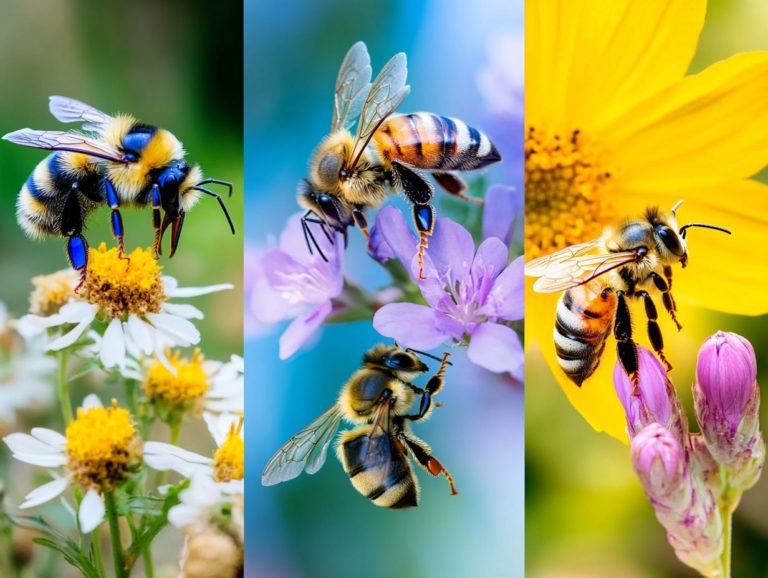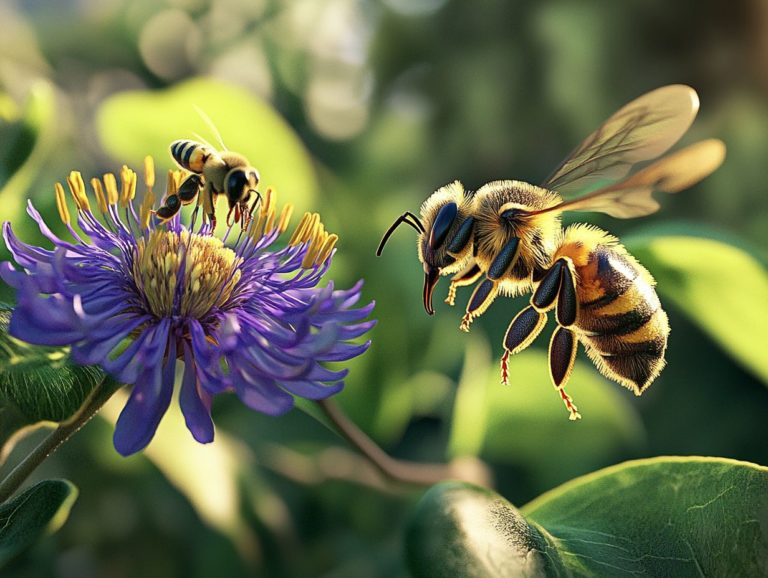The Intriguing Behavior of Bumblebees
Bumblebees are fascinating creatures that play an essential role in our ecosystems. They are not only vital for plants but also for humanity due to their unique behaviors and impressive pollination skills.
This exploration covers the different types of bumblebee behavior, factors influencing their actions, and the threats they face today. You will also learn about conservation efforts and practical ways to help these remarkable pollinators thrive.
Get ready to dive into the amazing world of bumblebees!
Contents
- Key Takeaways:
- What Are Bumblebees?
- How Do Bumblebees Behave?
- Why Do Bumblebees Behave the Way They Do?
- How Do Bumblebees Communicate?
- What Is the Role of Bumblebees in the Ecosystem?
- How Do Bumblebees Contribute to Pollination?
- What Threats Do Bumblebees Face?
- What Can Be Done to Protect Bumblebees?
- What Are Some Interesting Facts about Bumblebees?
- Frequently Asked Questions
Key Takeaways:
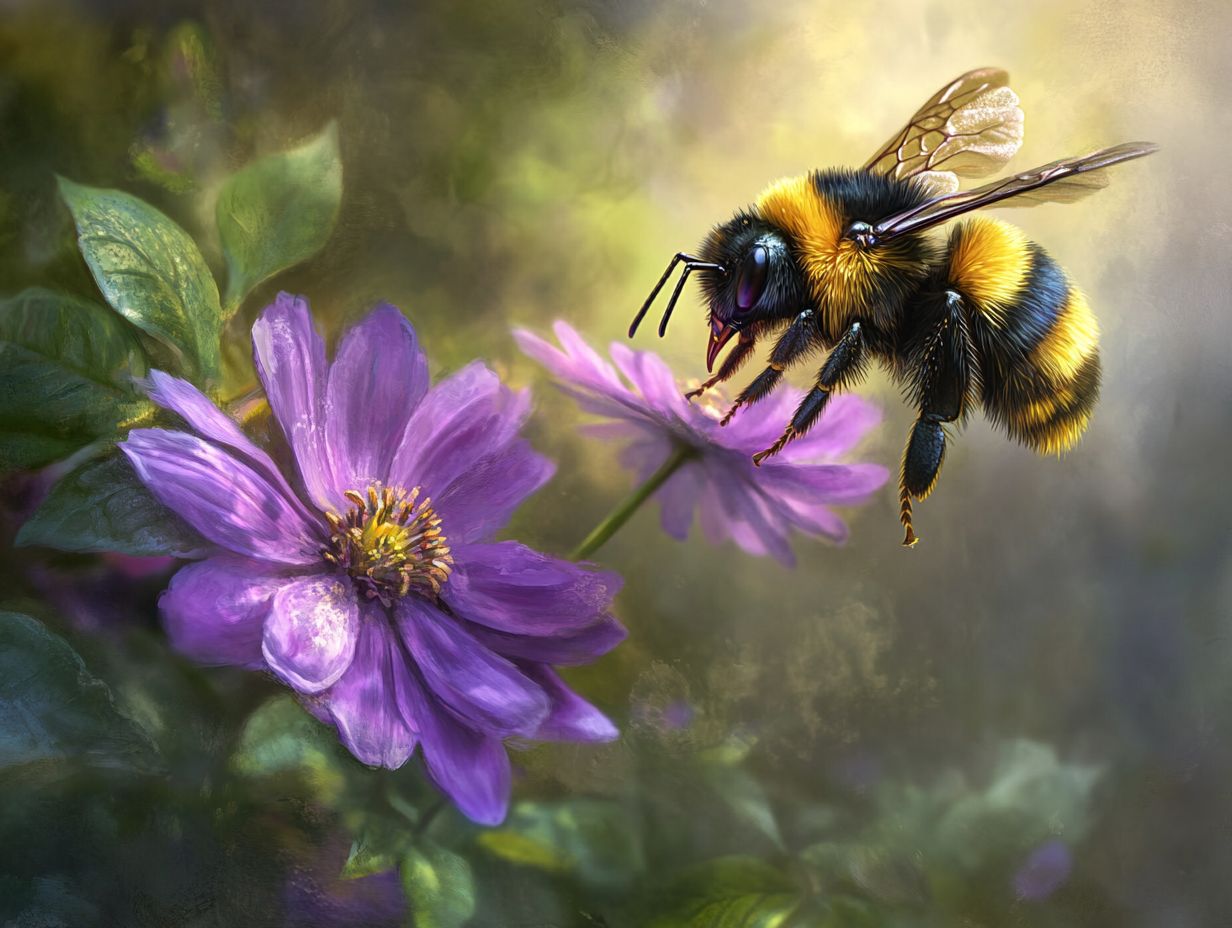
- Bumblebees play a crucial role in pollination. They are effective pollinators because they vibrate flowers to release pollen.
- Pesticides and habitat loss threaten bumblebee populations. This highlights the need for strong conservation efforts and individual actions.
- Despite their small size, bumblebees communicate in complex ways. They use buzzing and pheromones to coordinate activities within their community.
What Are Bumblebees?
Bumblebees belong to the genus Bombus in the Apidae family. They are captivating pollinators with a remarkable life cycle in their colonies.
In their intricate society, each member has a unique role: the queen bee, the hardworking worker bees, and the male drones. These social insects thrive in many environments, including the diverse landscapes of Pennsylvania.
Pennsylvania bees are vital for the state s biodiversity. They are essential to our ecosystems and agricultural crops, such as blueberries and tomatoes, because of their efficient pollen transfer.
Their behavior and reproductive traits support biodiversity conservation and advance ecological research. Studies in biology reveal the complex interactions of bumblebees and their ecosystem roles.
How Do Bumblebees Behave?
Bumblebee behavior combines instinct and learned patterns. They gather nectar and pollen from various flowers while ensuring their colony’s survival.
Factors like food supply heavily influence their behavior. Their social structure showcases a remarkable division of labor, where worker bees collect resources and respond to environmental cues.
What Are the Different Types of Bumblebee Behavior?
Bumblebee behavior is a fascinating tapestry woven from activities such as foraging, nesting, and social interactions. These elements are vital for the colony’s survival and reproductive success.
Bumblebees are discerning when it comes to nesting. They often choose sites that support their lifecycle from egg-laying to the solitary phase.
Bumblebees exhibit remarkable foraging techniques. They communicate through intricate dances to share the location of food sources.
Nesting preferences are equally important. They prefer sheltered spots like abandoned burrows or dense vegetation for protection.
Within the colony, a clear social structure emerges. Worker bees, queen bees, and male drones each play a crucial role in maintaining colony health.
These behaviors are not just instinctual; they crucially impact reproductive outcomes. Successful mating enhances genetic diversity and helps populations adapt to environmental changes.
Why Do Bumblebees Behave the Way They Do?
Bumblebee behavior is linked to survival strategies and the vital ecological roles they fulfill. Environmental factors deeply influence these behaviors.
As you observe these remarkable creatures, consider how factors like the availability of floral resources dictate their foraging patterns. Genetic contributions shape their social behaviors and adaptability to changing environments.
Research by institutions such as Penn State and Harvard University has significantly contributed to our understanding of these factors.
What Factors Influence Bumblebee Behavior?
Several factors influence bumblebee behavior. Temperature cues are among the most critical.
The availability of nectar and pollen resources affects foraging efforts and social interactions. Colony size influences fat storage and nutrient stores.
When temperatures rise, foraging periods can extend. Extreme heat or cold can reduce activity levels.
Some bumblebee species thrive in environments rich in wildflowers. Others prefer specific flower types based on their habitat.
Social dynamics within the colony impact group behavior. Larger colonies often show more complex foraging strategies.
Seasonal solitary phases also influence colony dynamics.
How Do Bumblebees Communicate?
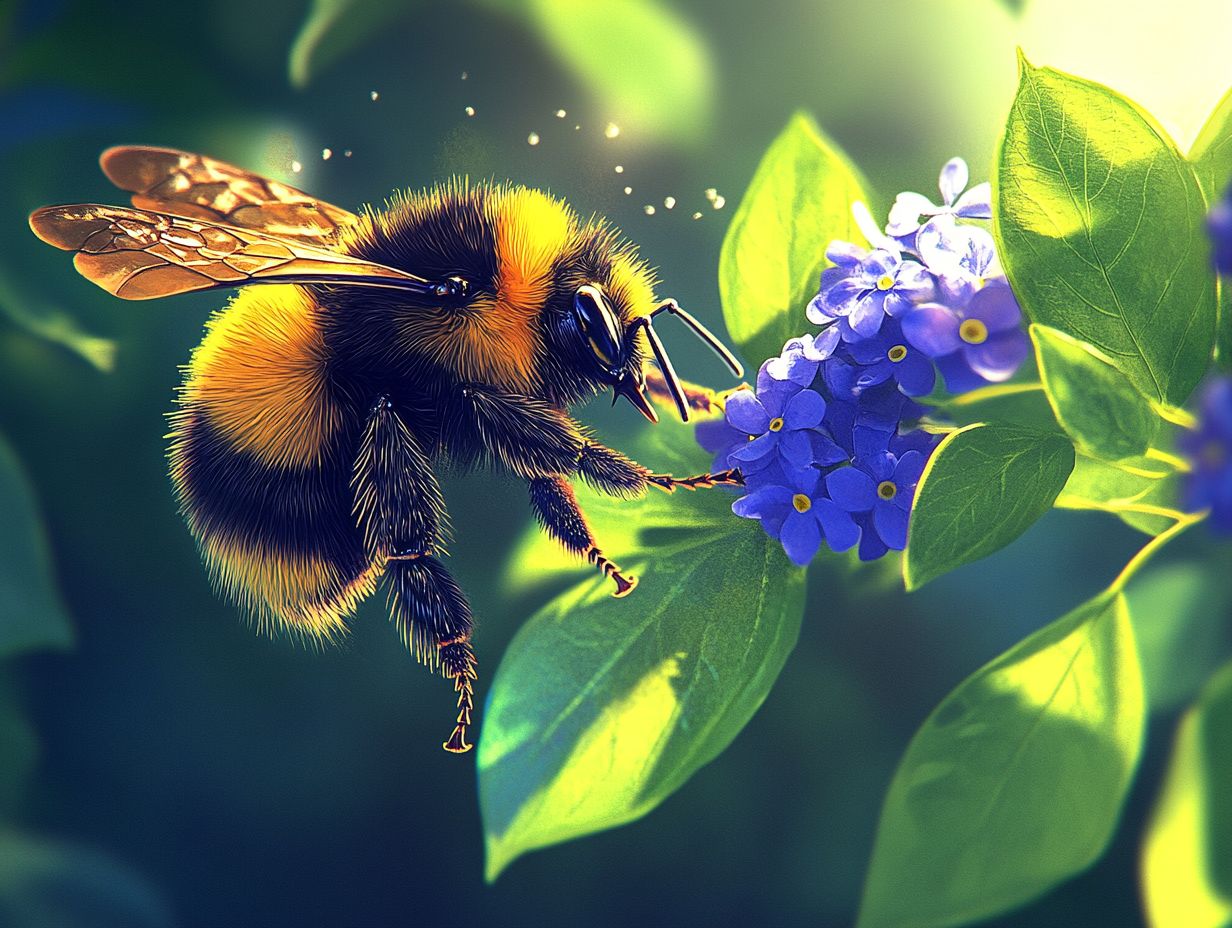
Bumblebees communicate in many fascinating ways. They primarily rely on buzzing frequencies, effectively conveying vital information about resources and potential threats to their colony.
This complex communication showcases the intricacies of bee anatomy and behavior. They also use chemical signals called pheromones, which help maintain the social structure within the bee community and improve coordination among colony members. Pheromones are critical during the egg-laying phase and indicate female reproductive readiness.
What Types of Communication Do Bumblebees Use?
Bumblebees utilize a variety of communication methods, primarily relying on vibrations and pheromones to share vital information about foraging sites and the overall status of their colonies. These techniques are essential for social interactions, allowing bumblebees to coordinate their activities and respond effectively to environmental changes.
The sophisticated use of vibrations, such as buzzing and substrate vibrations, enables them to alert each other about available food sources. Pheromones are crucial for indicating reproductive readiness and triggering alarm responses within the colony. Recent studies have significantly enhanced our understanding of these behaviors.
Research reveals exciting insights about how bees communicate. These insights showcase not only their remarkable adaptability but also the vital roles they play in pollination and maintaining ecosystem health. Understanding these strategies can help assess how environmental stressors impact bee populations, ultimately informing conservation efforts designed to protect these essential pollinators.
What Is the Role of Bumblebees in the Ecosystem?
Bumblebees hold a vital position in the ecosystem as highly effective pollinators. They significantly enhance the pollination process for many agricultural crops and native plant species. Their diligent work bolsters the food system and plays a key role in biodiversity conservation, emphasizing their essential contribution to maintaining healthy ecosystems.
How Do Bumblebees Contribute to Pollination?
Bumblebees play a vital role in pollination, showcasing impressive efficiency in transferring pollen. This efficiency significantly benefits a diverse array of floral resources and agricultural crops. Their distinctive foraging behavior boosts the reproductive success of many plant species.
What Makes Bumblebees Effective Pollinators?
Bumblebees are celebrated for their exceptional prowess as pollinators. Their unique adaptations, like specialized hairs that collect nectar and pollen, along with their distinctive buzzing frequency, allow them to effectively buzz pollinate, shaking pollen loose from flowers.
With their robust bodies, bumblebees deftly navigate through intricate floral structures, easily reaching deep into bell-shaped and tubular flowers. They engage in fascinating behaviors like nectar robbing and flower constancy, visiting the same type of flower repeatedly to enhance pollination efficiency. The role of nutrient stores, particularly fat body storage, is also critical during their foraging activities.
This close interaction with diverse plant species not only supports their reproductive processes but also fosters biodiversity. By nurturing these intricate relationships, bumblebees maintain the delicate balance of our natural world and food system.
What Threats Do Bumblebees Face?
Bumblebees encounter a range of threats that jeopardize both their populations and their essential roles within ecosystems. Among the most pressing concerns are habitat loss and exposure to harmful substances, particularly neonicotinoid pesticides (a class of insecticides known to harm beneficial insects).
Moreover, climate change introduces significant challenges by altering their natural habitats and disrupting the availability of crucial floral resources.
How Do Pesticides Affect Bumblebee Behavior?
Pesticides, especially neonicotinoid pesticides, are known to have a negative impact on bumblebee behavior, affecting their foraging efficiency and the overall dynamics of their colonies. Research has shown that exposure to these chemicals can impair cognitive functions and disrupt communication among bees, putting their survival and reproductive success at risk.
The behavioral changes can disrupt the colony lifecycle, affecting both worker bees and male drones. Recent studies have brought to light that these effects are not confined to individual bees; they ripple through the entire colony, affecting its ability to thrive.
For example, in agricultural environments and agricultural crops like blueberries and tomatoes, bumblebees exposed to neonicotinoids demonstrated diminished foraging activity, resulting in reduced resource acquisition. This decline in foraging efficiency not only compromises the nutritional intake essential for colony development, but it also weakens the resilience of bumblebee populations as they confront environmental stressors.
The broader implications of these findings are significant, indicating that a decline in bumblebee health could disrupt crucial pollination services that many crops rely on, ultimately impacting agricultural productivity and the ecological balance necessary for maintaining diverse plant communities and biodiversity conservation.
What Other Factors Contribute to Bumblebee Decline?
In addition to pesticide exposure, several factors also contribute to the decline of bumblebee populations. Habitat loss, climate change, and the resulting impact on food supply all create a perfect storm of challenges that hinder bumblebee survival and reproductive success in their natural environments, affecting bumblebee species worldwide.
Habitat destruction, primarily driven by urban development and agricultural expansion, significantly reduces the spaces where bumblebees can thrive. As flowers disappear and nesting sites become increasingly scarce, their ability to find essential resources diminishes.
Shifting climate patterns further complicate the situation by disrupting the timing of blooming cycles. This leads to a mismatch in the availability of food sources when bumblebees emerge from hibernation. The scarcity not only impacts their immediate nourishment but also affects their reproductive capabilities, including the egg-laying phase, making it all the more challenging for populations to recover.
These factors highlight the urgent need for robust conservation efforts that focus on habitat restoration, climate resilience, and sustainable agricultural practices. By addressing these issues, you can play a vital role in supporting bumblebee recovery.
What Can Be Done to Protect Bumblebees?
Act now to protect bumblebees! Your dedicated efforts are crucial. Protecting bumblebees demands conservation strategies that enhance their habitats and promote biodiversity.
By engaging with bee enthusiasts, community organizations, and researchers, you can help create initiatives that provide safe environments for bumblebees to flourish.
Ultimately, these efforts will also raise awareness about the vital ecological roles these pollinators play in our ecosystems.
What Conservation Efforts Are in Place?
Numerous conservation efforts are currently underway to protect bumblebee habitats and increase their populations, with organizations committed to ecological research and biodiversity conservation leading the charge. You ll find strategies like habitat restoration projects, public awareness campaigns, and policy advocacy all aimed at mitigating the threats faced by these important pollinators.
One particularly noteworthy initiative involves the restoration of wildflower meadows, which not only provide essential food sources for bumblebees but also support a rich diversity of other species. This project exemplifies collaboration among scientists who monitor population changes, local communities that actively engage in planting and maintaining flowers, and policymakers who champion supportive land-use regulations.
Additionally, the Bumblebee Conservation Trust has been pivotal in these efforts.
Successful case studies from places like the UK and North America highlight the tangible improvements in bumblebee populations resulting from these cooperative efforts. These examples serve as a powerful reminder that comprehensive approaches uniting various stakeholders can lead to significant progress in enhancing biodiversity and strengthening ecosystem resilience.
How Can Individuals Help Bumblebees?
You can play a pivotal role in supporting the protection and conservation of bumblebees by engaging in meaningful actions that champion their cause. You can make a huge impact with simple steps, such as gardening for bees and raising awareness about their ecological importance. By planting bee-friendly flowers and reducing pesticide use, you help create vital habitats that encourage bumblebee populations to thrive. You can also support bee enthusiasts and local ecological research.
Enhancing your garden with native plants that bloom throughout the seasons is a great way to help. Supporting local community initiatives focused on creating pollinator gardens will further amplify these efforts, making your contributions even more significant. Additionally, consider adding honey bees to your garden to complement bumblebees in the pollination process.
Get involved with local environmental groups or participate in workshops; these experiences will supercharge your understanding of the challenges bumblebees face, inspiring others to take action as well. Advocating for policies that protect pollinator habitats and prevent the use of harmful pesticides is essential. By recognizing how your personal choices affect the environment, you can contribute meaningfully to bumblebee conservation, fostering a healthier ecosystem for generations to come.
What Are Some Interesting Facts about Bumblebees?
Bumblebees are truly captivating beings, and there s a wealth of intriguing information that underscores their remarkable adaptations and vital role in the ecosystem. Their bee anatomy, including specialized hairs and pollen baskets, showcases their evolutionary design for efficient pollen transfer.
For example, certain species of bumblebees possess the exceptional ability to buzz pollinate a technique that significantly boosts their efficiency in transferring pollen among various flower species. Buzz pollination is when bumblebees vibrate their bodies to release pollen from flowers. This not only aids in the reproduction of plants but also plays an essential part in promoting biodiversity. The process involves the use of specific buzzing frequency to release pollen from flowers, enhancing pollination efficiency.
Frequently Asked Questions
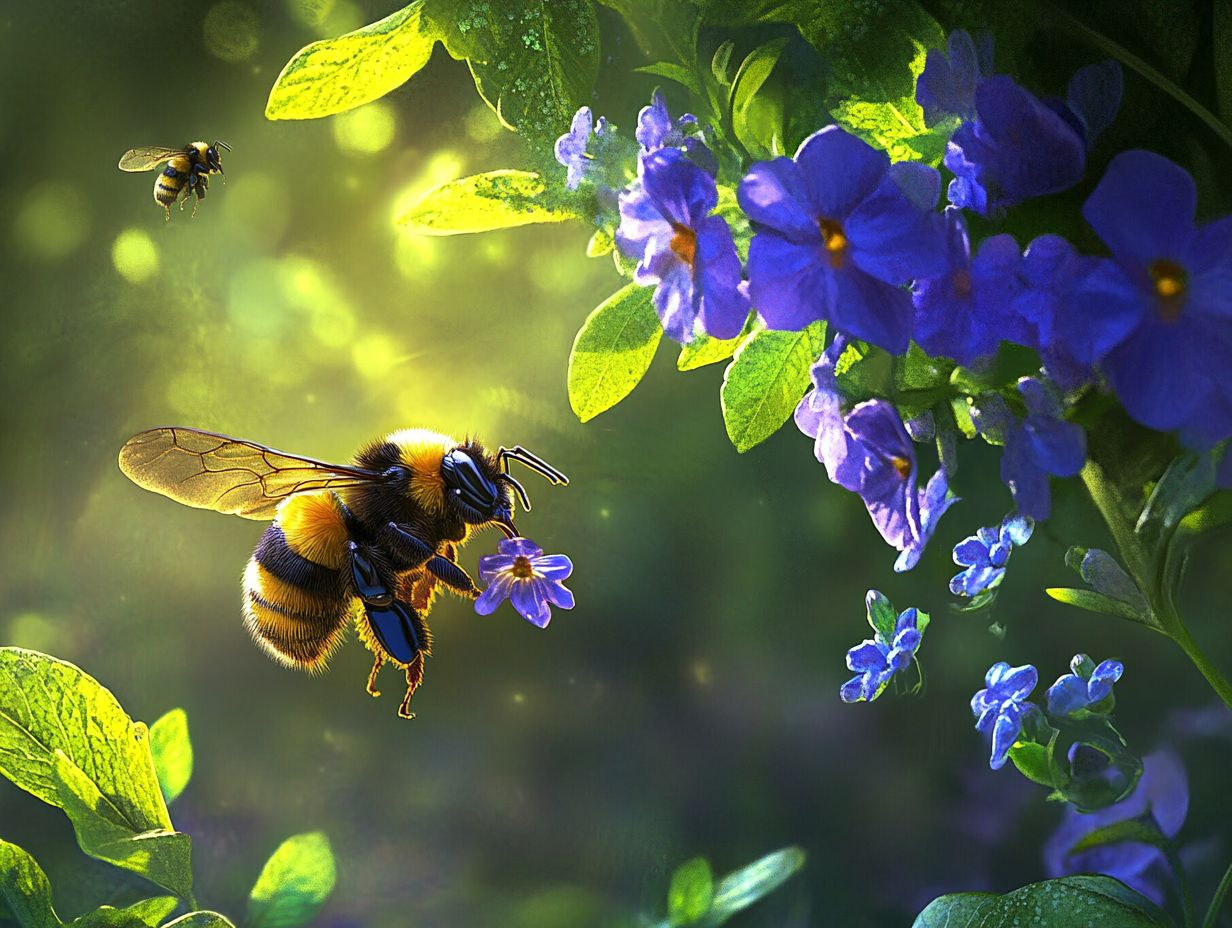
What makes the behavior of bumblebees so intriguing?
The behavior of bumblebees is fascinating because they have unique social structures, complex communication methods, and exhibit adaptive behaviors to survive in their environment. The division of labor within the colony, involving queen bees, worker bees, and male drones, highlights their efficient social organization.
Do all bumblebees have the same behavior?
No, the behavior of bumblebees can vary depending on their species, environment, and individual characteristics.
How do bumblebees communicate with each other?
Bumblebees use chemical signals, vibrations, and movements called “dance” to share information about food.
These methods help the colony find flower resources and nectar.
Why do bumblebees perform “buzz pollination”?
Bumblebees buzz pollinate by shaking their bodies to release pollen from hard-to-reach flowers.
This technique is great for crops like blueberries and tomatoes.
What is the role of bumblebees in their ecosystems?
Bumblebees are nature’s incredible pollinators.
They help maintain the health and diversity of plants and animals in their ecosystems.
How do bumblebees adapt to survive in their environments?
Bumblebees adapt by changing their foraging patterns and adjusting their nests.
They also manage their body temperature to survive and store fat to help them through tough seasons.

